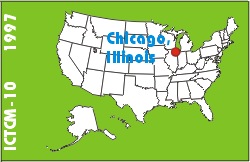
Electronic Proceedings of the Tenth Annual International Conference on Technology in Collegiate MathematicsChicago, Illinois, November 6-9, 1997Paper P008TangentField: A tool for 'webbing' the learning of differential equations |
Margaret JamesMathematics Department Imperial College, University of London UK Phone: +44(0) 171 594 8503 | Phillip KentMathematics Department Imperial College, University of London UK Phone: +44(0) 171 594 8503 p.kent@ic.ac.uk | Phil RamsdenMathematics Department Imperial College, University of London UK Phone: +44(0) 171 594 8503 |
| Click to access this paper: |
ABSTRACT
Direction fields, or 'tangent fields' as we have called them, are a familiar visual representation for ordinary differential equations, linking a first order ODE with its solutions by distributing little 'tangent stubs' across the x-y plane, whose slopes are specified by the ODE. Typically this representation is encountered in learning about ODE's after a thorough treatment of algebraic solution methods, especially for studying ODE's that cannot, or cannot easily, be solved in closed form. We wished to try a very different role for this representation, as a starting point for undergraduate students to learn about the concept of 'differential equation'.We designed a tool called 'TangentField' in Mathematica, and a set of activities for its use. In using TangentField, anyone familiar with the concept of differential equation recognises the families of solutions which appear visually. However, learners do not need the concept of solutions to see curves - we hoped that the learners in constructing a meaning for these families of curves would through this construct the concepts of 'solutions' and 'differential equation'. And also that they would re-construct their understanding of 'derivative', which research suggests is often strongly bound up with its meaning in differentiation as derivative-at-a-point.
Noss & Hoyles ('Windows on Mathematical Meanings', Kluwer Academic, 1996) have extensively researched the idea of constructing computational tools in which the expert perceives an embedded structure but which are also intended to be in agreement with a learner's initial conceptions, and responsive to the learner's developing conceptions. They coined the term 'webbing' for such a structured, yet locally responsive, learning environment.
We do not wish to use TangentField as a way of replacing the formal meanings and algebraic language of differential equations: on the contrary, we intend that access to the formal meanings should be facilitated by computational activity. For that to happen, the learners must come to recognise explicitly the general structure that they are relying on implicitly as they work with TangentField. But in the meantime, they can rely on it, and build a rich conceptual image before formal definitions are needed. They must also forge links between the representations of equations and families of solutions as expressed in tangent fields, and those that they meet in the algebraic language of ODE's.
We describe the theoretical basis for our design work, and present an analysis of some student work on the TangentField activities, and say how we see this analysis feeding into the next cycle of design.
Keyword(s): differential equations, Mathematica, Internet
